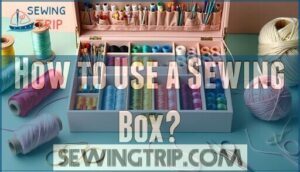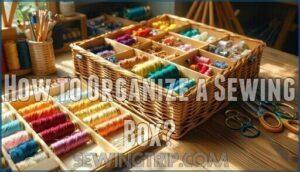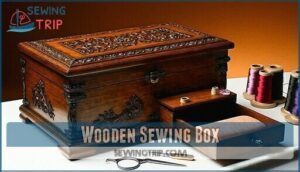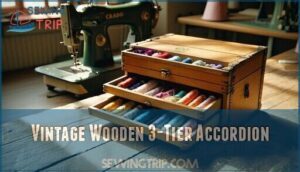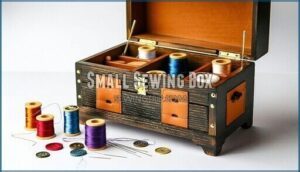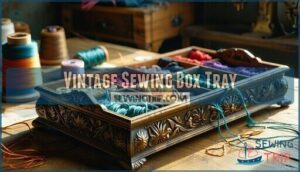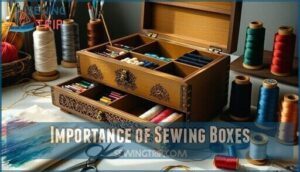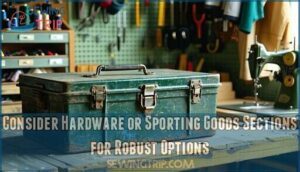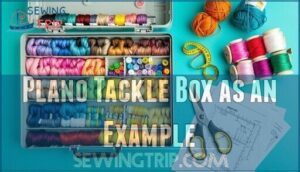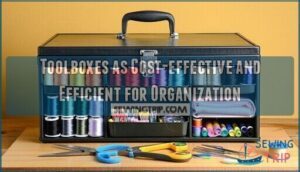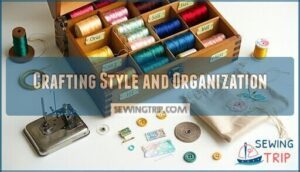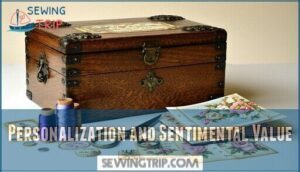This site is supported by our readers. We may earn a commission, at no cost to you, if you purchase through links.
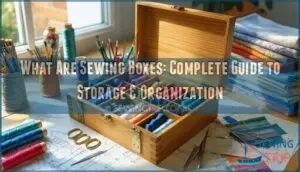
These storage solutions come in materials like wood and plastic, with features ranging from simple dividers to multi-tiered expandable designs. Whether you’re heading to a sewing class or working at home, a well-organized sewing box keeps everything at your fingertips.
Smart organization turns chaos into control, but choosing the right style and size makes all the difference in your crafting experience.
Table Of Contents
- Key Takeaways
- What is a Sewing Box?
- How to Use a Sewing Box?
- How to Organize a Sewing Box?
- Examples of Sewing Boxes
- Importance of Sewing Boxes
- Choosing The Right Container
- Crafting Style and Organization
- Sewing Boxes and Toolboxes Requiring Effective Organization
- Identifying Frequently Used Items for Easy Access
- Storing Less-used Items Out of The Way but Easily Accessible
- Considering Personal Craft Style for Organization Preferences
- Craft Style Influencing The Choice Between Neat Labeling or a More Accessible Layout
- Personalization and Sentimental Value
- Frequently Asked Questions (FAQs)
- Conclusion
Key Takeaways
- You’ll transform scattered sewing chaos into an organized workspace by using specialized containers with compartments for threads, needles, scissors, and notions that keep everything accessible and portable.
- You can choose from various materials like durable wooden boxes for longevity or lightweight plastic options for travel, with sizes ranging from compact kits to multi-tiered expandable designs that match your specific needs.
- You’ll save money and get better organization by considering tackle boxes or toolboxes from hardware stores, which often provide superior durability and compartment flexibility compared to traditional sewing boxes at lower costs.
- You’ll maximize efficiency by organizing frequently used items in top compartments while storing specialty supplies in secondary sections, creating a personalized system that reflects your crafting style and workflow preferences.
What is a Sewing Box?
When you’re ready to take control of your crafting chaos, a sewing box becomes your best ally. This dedicated storage container organizes your sewing supplies, sewing accessories, and sewing notions in one convenient location. Think of it as your personal command center for all things stitching.
A proper sewing box offers compartments for your sewing essentials—needles, thread, buttons, and measuring tools. Box materials range from sturdy wood to lightweight plastic, each providing different storage solutions for your crafting tools. Whether you’re working with a compact sewing kit or an extensive collection, these containers keep everything accessible.
The beauty lies in customization. You can arrange compartments based on your sewing basics needs, creating a system that works specifically for your projects. From beginners learning fundamental techniques to experienced sewers managing complex quilting supplies, a well-chosen sewing box transforms scattered materials into an organized workspace that puts you firmly in charge of your craft.
How to Use a Sewing Box?
You’ll start using your sewing box effectively by conducting a thorough inventory check to identify what supplies you currently have and what you need to add.
Next, you’ll organize basic items like needles, thread, scissors, and pins in designated compartments, then select the right box size and style that matches your specific sewing projects and storage requirements.
Inventory Check
Smart sewers know that effective supply management starts with a thorough inventory check. Your sewing box organization depends on understanding what you have before determining what you need.
- Stock Tracking: Count thread spools, needles, and notions to identify gaps in your dedicated storage system.
- Item Categorization: Group similar supplies together for efficient inventory management and quick access.
- Storage Solutions: Evaluate your current organized system to refine space and improve inventory efficiency.
Basic Items Included
Every well-stocked sewing kit contains essential sewing supplies that’ll keep you prepared for any project. Your basic sewing accessories should include various thread types in common colors, needle sets for different fabric weights, sharp fabric scissors, measuring tape, and seam rippers.
Don’t forget sewing notions like buttons, pins, and safety pins for quick fixes. Quality fabric markers help with pattern placement, while proper scissor care keeps your tools sharp and ready.
Choosing The Right Sewing Box
Sewing box materials greatly impact durability and functionality. Plastic offers lightweight convenience and rust-proof benefits, while wooden boxes provide classic appeal with exceptional longevity.
Consider these factors when choosing a sewing box:
- Sewing box materials: Wooden options last longer but weigh more than plastic alternatives
- Box size options: Small boxes suit beginners; large compartments accommodate extensive supplies
- Portability features: Grips and compact designs enable easy transport to classes
- Storage compartments: Multiple trays and dividers organize notions efficiently
- Sewing needs assessment: Match box capacity to your current and future project requirements
When selecting a sewing box, understanding the importance of unique sewing historiessewing box stories can help you appreciate the value of a well-organized storage system.
How to Organize a Sewing Box?
You’ll save countless hours by organizing your sewing box using a logical system that groups similar items together and places frequently used tools in easily accessible compartments.
Start by categorizing supplies into thread storage, needle organization, and designated spaces for larger items like scissors and measuring tape, then use dividers or small containers to create separate sections that prevent items from shifting around during transport.
Thread Storage
Thread management starts with strategic spool organization in your sewing box. Use small containers or dividers for color coding different threads, making fiber sorting easy. Store spools upright to prevent tangling, and group similar shades together.
Consider using thread racks or pegboards for frequently used colors. This yarn storage system keeps your sewing supplies organized and accessible during projects.
Storage for Larger Items
After organizing your thread collection, you’ll need smart solutions for bulkier sewing supplies. Large Item Storage becomes manageable when you match containers to contents. Your sewing box might feel cramped, but Storage Solutions exist for every situation.
Here’s how to tackle sewing storage for oversized items:
- Use fabric bins with clear windows for batting, interfacing, and pattern pieces
- Install crafting shelves above your workspace for seasonal supplies and reference materials
- Choose a MultiLayer Storage Box with adjustable compartments for scissors, rulers, and cutting mats
- Convert a storage box into Sewing Box Expansion space for specialty tools and machine attachments
Strategic sewing organization means keeping frequently-used large items within arm’s reach while storing occasional-use supplies nearby but accessible.
Organizational Tips
Smart supply sorting transforms your sewing station into an efficient workspace. You’ll want to group similar sewing tools together—threads by color, needles by size, and buttons by project.
Transform your sewing chaos into an efficient workspace by grouping similar tools together
Use small containers for organizing strategies that work: pill bottles for tiny notions, magnetic strips for metal tools. These workspace optimization storage hacks create functional crafting systems that’ll make you wonder how you survived the chaos before.
Examples of Sewing Boxes
You’ll find sewing boxes in various materials and designs, from classic wooden chests with multiple tiers to compact plastic organizers with removable trays.
Whether you choose a vintage accordion-style box that expands to reveal numerous compartments or a simple tray-style container for basic supplies, each type offers specific advantages for different sewing needs and storage preferences.
Wooden Sewing Box
Since ancient times, wooden materials have offered unparalleled durability for sewing storage solutions. Traditional wooden sewing box designs feature compartments that adapt to your craft organization needs.
You’ll find handmade boxes provide exceptional longevity compared to plastic alternatives. Vintage wooden boxes often include built-in pincushions and thread holders, making sewing box organization hassle-free for any project.
Vintage Wooden 3-Tier Accordion
Vintage wooden accordion sewing boxes showcase timeless craftsmanship with their expandable tiered storage design. These antique sewing boxes feature handcrafted details that make organization both functional and beautiful.
- Multiple compartments expand like an accordion for maximum storage
- Traditional wooden sewing box designs blend vintage charm with practical utility
- Antique boxes offer durability that’s lasted generations
The wooden sewing box’s tiered storage system lets you access supplies without disturbing other compartments.
Small Sewing Box
Compact organizers don’t mean compromising on functionality. A small sewing box or mini storage case packs essential sewing accessories into a portable format.
These travel boxes feature compartments for thread, needles, and buttons while fitting easily in your bag. Perfect for quick repairs or crafting on-the-go, a portable sewing kit keeps your essentials organized.
Vintage Sewing Box Tray
When considering heirloom storage options, vintage sewing box trays offer unique charm and functionality. These collectible boxes feature compartmentalized designs perfect for sewing box organization.
Antique restoration can revive wooden sewing box pieces, while vintage designs add character to your craft space. Many vintage items include decorative sewing tray elements that complement modern storage needs beautifully.
Various Styles Catering to Individual Preferences and Needs
Today’s sewing box designs offer amazing variety to match your crafting style. You’ll discover whimsical fabric-covered sewing baskets with animal themes, multi-drawer wooden sewing boxes with cantilever mechanisms, and compact portable storage solutions.
Modern organizer systems include repurposed tackle boxes with custom compartments, while vintage sewing box designs feature premium finishes. Whether you need basic sewing kits or elaborate wooden sewing box collections, there’s a perfect match for your creative needs.
When selecting a sewing box, consider the importance of proper sewing supply storage to keep your workspace organized.
Importance of Sewing Boxes
You’ll transform your scattered sewing chaos into an efficient workspace when you invest in a quality sewing box that keeps threads, needles, and notions organized in designated compartments.
Your projects become more enjoyable and productive because you won’t waste time hunting for that specific button or seam ripper when inspiration strikes.
Essential for Organized Travel With Necessary Supplies
When you’re traveling to sewing classes or craft retreats, your sewing box becomes your mobile command center. Travel sewing boxes transform chaotic supply cases into organized crafting essentials that won’t let you down.
Pack these portable solutions strategically:
- Travel Kits – Thread, needles, scissors in compact compartments
- Sewing Bundles – Pre-sorted supplies for specific projects
- Portable Storage – Quick-access pockets for emergency repairs
Durability and Cost-effectiveness
Beyond initial appeal, your sewing box investment hinges on material selection and durability testing. Quality construction materials guarantee longevity factors that justify cost analysis over time. Budget options exist, but cheaper materials often require frequent replacement, negating savings. Proper sewing box maintenance extends equipment life considerably.
- Peace of mind knowing your sewing supplies are protected for years
- Financial freedom from constantly replacing broken storage solutions
- Professional confidence with reliable sewing box organization systems
- Creative flow uninterrupted by equipment failures during projects
- Legacy satisfaction passing down quality sewing equipment to future generations
Availability in Convenient Sizes for Easy Transportation
You’ll find sewing boxes in sizes ranging from compact designs perfect for travel sewing to larger models for home use. These portable companions feature lightweight materials and smart packing solutions that streamline space.
Compact designs with portable features make travel organization hassle-free, transforming any location into your creative workspace. Your travel essentials stay protected while maintaining on-the-go sewing convenience.
Facilitating Quick and Easy Access to Items for Sewing and Crafting Enthusiasts on The Go
Whether you’re tackling a quick hem at work or teaching a weekend class, your portable companion becomes invaluable. Well-designed sewing kits transform chaotic moments into efficient workspace solutions, guaranteeing crafting essentials stay within arm’s reach. Strategic sewing box organization creates smooth travel organization that adjusts to your creative rhythm.
- Never miss a creative moment – your travel cases keep sewing accessories ready for spontaneous projects
- Transform any space instantly – portable storage turns hotel rooms into functional studios
- Conquer deadlines confidently – sewing box DIY solutions guarantee you’re always prepared
Choosing The Right Container
You don’t need to spend a fortune on specialized sewing containers when practical alternatives exist in unexpected places.
Hardware stores and sporting goods sections offer tackle boxes and toolboxes that provide better organization, durability, and value compared to traditional sewing boxes.
Average Cost of Sewing Boxes
When planning your budget analysis, sewing box prices generally range from $10 to $25 for basic models, while premium wooden options reach $80-$150. Cost factors include sewing box materials, compartments, and brand reputation affecting overall expense reduction.
- Entry-level plastic organizers start at $10-$15
- Mid-range Singer sewing box models cost $25-$35
- Premium wooden boxes with multiple tiers range $50-$100
- Vintage collector pieces can exceed $150
Consider Hardware or Sporting Goods Sections for Robust Options
Don’t overlook the hardware or sporting goods sections when hunting for sturdy storage solutions. These departments offer durable containers with heavy-duty latches, reinforced corners, and weatherproof seals that surpass traditional sewing boxes.
Hardware options include metal toolboxes with multiple compartments, while sporting goods provides tackle boxes designed for outdoor use.
These sturdy materials withstand frequent transport and protect your sewing equipment organization from damage better than standard options.
Tackle Boxes and Toolboxes as Viable Choices
Durable hardware and sporting goods options deserve your attention when seeking portable storage alternatives. Tackle boxes and toolboxes provide standout solutions for organizing sewing equipment, offering adjustable compartments and fishing box conversion potential.
- Portable Storage – Grips and secure latches enable easy transport
- Toolbox Alternatives – Cost-effective modular organization systems
- Crafting Containers – Clear compartments for visual inventory checks
- Storage Systems – Stackable designs make the most of space efficiency
- Modular Organization – Removable trays separate frequently used sewing tools
Plano Tackle Box as an Example
The Plano tackle box stands out as a prime Sewing Box Alternatives example for tackle box conversion. These Portable Storage systems feature Custom Compartments that adjust to fit your thread, needles, and buttons perfectly.
With excellent Space Optimization design, you’ll organize everything from pins to measuring tape efficiently in one compact sewing organizer.
Toolboxes as Cost-effective and Efficient for Organization
Unlike traditional sewing boxes, standard hardware toolboxes offer exceptional cost savings while maximizing space optimization. Their sturdy construction creates an efficient workspace that manages heavy sewing tools with ease.
- Portable Storage – Multiple compartments for threads, needles, and larger items
- Efficient Layout – Removable trays provide quick access to frequently used supplies
- Cost Savings – Hardware stores offer better prices than craft retailers
- Organization Tips – Deep wells accommodate fabric scissors and rulers perfectly
Crafting Style and Organization
Your crafting style directly influences how you’ll organize your sewing box, with some sewers preferring labeled compartments while others favor quick-access layouts.
You’ll need to identify which supplies you reach for most often and position them for immediate access, while storing specialty items in secondary compartments.
Sewing Boxes and Toolboxes Requiring Effective Organization
Most sewing boxes and toolbox alternatives don’t automatically achieve crafting efficiency without intentional organizational systems in place. Both storage solutions require structured approaches to enhance their potential—you’ll need dividers, labeled compartments, and smart placement strategies.
Effective sewing box design includes designated spots for sewing tools and accessories, while toolbox alternatives offer similar benefits with added durability for thorough sewing supply organization.
Identifying Frequently Used Items for Easy Access
Your sewing kit’s efficiency depends on identifying which sewing essentials you reach for most. Place frequently used sewing tools like scissors, needles, and measuring tape in your sewing box’s top compartments.
Keep thread, pins, and seam rippers within arm’s reach for quick supply management. This accessible storage strategy transforms chaotic crafting into smooth workflow.
Storing Less-used Items Out of The Way but Easily Accessible
Once you’ve identified your go-to tools, smart storage solutions help keep less-used items accessible yet organized. Item rotation ensures seasonal supplies stay current while hidden compartments enhance space optimization. Consider these efficient retrieval methods:
- Bottom drawer treasures – specialty tools waiting for their moment to shine
- Back pocket surprises – backup supplies that save the day
- Upper shelf gems – decorative items that spark joy between projects
- Corner hideaways – bulky materials tucked safely away
- Deep storage champions – rarely-used accessories ready when needed
Accessible shelves and dedicated storage create harmony between convenience and space efficiency in your sewing box organization.
Considering Personal Craft Style for Organization Preferences
Your crafting needs shape how you organize storage solutions in your sewing box. Some sewers prefer neat labeling systems, while others want everything visible at a glance.
Consider your sewing habits and creative personality when choosing organization tips. Your personal style determines whether you’ll love compartmentalized storage or prefer an open layout where your creative arsenal stays accessible.
Craft Style Influencing The Choice Between Neat Labeling or a More Accessible Layout
Your creative personality drives how you’ll organize your sewing box, with neat labelers preferring structured systems while free spirits favor accessible storage. Consider these organizational preferences:
- Craft Aesthetics – Match your sewing box design to your workspace style
- Labeling Systems – Use clear tags for precise organization or skip them for quick access
- Accessible Storage – Prioritize frequently used tools in easy-reach compartments
- Sewing Box Functionality – Balance visual appeal with practical tool management
- DIY Customization – Create dividers that reflect your efficient organizational needs
Personalization and Sentimental Value
Your sewing box becomes a personal treasure chest when you add vintage family heirlooms, custom-made organizers, and meaningful keepsakes that connect you to past generations of crafters.
These unique touches, from grandmother’s antique scissors to laminated measuring bookmarks you’ve created, transform a simple storage container into a cherished workspace that tells your unique sewing story.
Safely Storing and Organizing Vintage Items
Your vintage sewing box maintenance deserves proper antique preservation techniques to protect those treasured collectible display pieces. Handle heritage conservation by storing items in acid-free containers, maintaining stable temperatures, and avoiding moisture exposure.
- Use acid-free tissue paper between delicate vintage items
- Store metal components with desiccant packets to prevent rust
- Keep wooden pieces away from direct sunlight
- Clean vintage sewing tools with appropriate pH-neutral solutions
- Document each item’s condition for ongoing sewing box organization tracking
Adding Personalized Items Like Laminated Measuring Bookmarks
Beyond storing vintage treasures, you’ll want to create custom measuring aids that serve double duty. Laminated measuring bookmarks combine practicality with personal flair in your sewing box organization. Here’s how these unique tools work:
| Feature | Purpose |
|---|---|
| Measurement markings | Quick fabric calculations |
| Laminated protection | Durability for frequent use |
| Personal design | Reflects your crafting style |
| Compact size | Fits in any sewing box |
These one-of-a-kind labels transform basic sewing accessories into meaningful crafting accessories. Add measuring tape conversions, seam allowances, or your grandmother’s favorite stitching tips. They’re waterproof, won’t tear, and become indispensable sewing tools.
Preserving Family History With Reminders of Past Generations
Your sewing box becomes a treasure chest when you incorporate Family Heirlooms and Ancestral Tools passed down through generations. These wooden vintage pieces carry historical context that transforms ordinary storage into Heritage Crafts preservation.
Consider these meaningful additions:
- Your grandmother’s silver thimble from her Legacy Quilting days
- Hand-forged scissors with worn grips
- Mother-of-pearl buttons saved from family garments
- Vintage measuring tools with brass fittings
This vintage appeal connects your modern projects to family history.
Enjoying The Sentimental Value of Old Buttons, Scissors, and Vintage Items
Transform your sewing box into a treasure chest by incorporating vintage buttons, antique scissors, and family heirlooms. These sewing accessories carry sewing memories that connect you to past generations through heritage preservation.
Vintage collecting enthusiasts appreciate how antique restoration breathes new life into forgotten sewing notions. Your sewing box decoration becomes meaningful when it houses items with vintage appeal and personal history.
Frequently Asked Questions (FAQs)
Where can I find unique and stylish sewing boxes?
Roughly 78% of crafters report frustration searching for quality storage solutions.
You’ll discover unique sewing boxes at Etsy for custom handmade pieces, antique shops for vintage treasures, and specialty craft retailers like Yarnplaza offering stylish functional options with fast shipping.
How do I clean and maintain a sewing box?
Empty your sewing box completely, then wipe down all surfaces with a damp cloth. Check compartments for loose threads or debris. Reorganize supplies by category and replace damaged items.
Can a sewing box be used for other crafts besides sewing?
You’ll find sewing boxes work perfectly for jewelry making, embroidery floss, art supplies, beading, and various small craft materials.
Their compartments adapt beautifully to organize everything from nail polish to hobby essentials.
What are some tips for maximizing storage space in a sewing box?
Use vertical dividers to create custom compartments, store small items in magnetic containers or pill boxes, and utilize every nook by adding foam padding with cutouts for specific tools.
Can sewing boxes accommodate machine sewing accessories?
Yes, sewing boxes can hold machine accessories like bobbins, presser feet, and specialty needles.
You’ll want compartments or small containers to keep these items organized and prevent them from getting lost or damaged.
What materials make sewing boxes most durable?
Wood and metal sewing boxes offer you the best durability, withstanding years of use without breaking. They’re heavier than plastic but won’t crack or warp like cheaper alternatives.
How do vintage sewing boxes differ from modern?
Like comparing a grandmother’s antique chest to a modern toolbox, vintage sewing boxes featured ornate brass fittings and carved wood details, while today’s versions prioritize lightweight plastic compartments and modular organization systems.
Are tackle boxes suitable for sewing supplies?
Tackle boxes work brilliantly for sewing supplies—those multiple compartments perfectly organize threads, bobbins, needles, and small notions.
You’ll find the adjustable dividers handle everything from tiny buttons to measuring tapes.
Whats the average lifespan of quality sewing boxes?
Ever wonder why your grandmother’s sewing box outlasted three kitchen renovations? Quality wooden sewing boxes last 15-25 years with proper care, while plastic versions usually survive 5-10 years, and metal options fade after just 3-7 years.
Conclusion
Like a craftsman’s toolbelt holds every essential within arm’s reach, what are sewing boxes becomes clear when you see how they transform scattered supplies into organized efficiency. You’ll find these containers simplify your workflow, whether you’re tackling a quick repair or major project.
They protect delicate items while keeping threads, needles, and notions systematically arranged. Your investment in proper storage pays dividends through reduced frustration and increased productivity.
Choose based on your specific needs, available space, and crafting frequency for ideal results.
- https://www.1stdibs.com/answers/what-is-a-sewing-box-called/
- https://kingsriverlife.com/05/10/a-tisket-a-tasked-check-out-grandmas-sewing-basket/
- https://www.displayguru.co.uk/blogs/news/sewing-organizer-box
- https://www.caringfortextiles.com/ode-to-lani-her-sewing-box-of-memories/
- https://rito.com/897-sewing-boxes-storage

